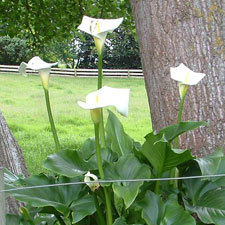 Arum lily
Arum lily
Common name: Arum lily; Death lily
Botanical name: Zantedeschia aethiopica
Management programme: Advisory
Originates from South Africa. Introduced to New Zealand as an ornamental garden plant and thought to have naturalised by 1870. All parts of the plant is poisonous and it is one of the National Poison Centre’s top ten poisonous plants; being consistently involved in unintentional or childhood poisonings.
Why is it a pest?
- Arum lily is long-lived and persists under regenerating canopy, forming dense patches excluding all other vegetation.
- It tolerates excessive water, wind, salt, hot to cold, moist soil types, moderate shade, and is drought-resistant once established.
- Stock avoid it as it is poisonous, allowing it to gradually dominate grazed sites.
- Arum lily is spread by seed fall near parent plants, and occasionally seeds are spread by birds, water and soil movement.
Where is it found?
Found in scattered patches throughout the Bay of Plenty. Arum lily is mostly found in swampy pasture and damp wasteland.
What does it look like?
- A robust, evergreen, clump forming lily up to 1.5m tall, with large (up to 45 cm long), leathery, dark green, arrow-shaped leaves.
- Large, white, funnel shaped flower with a yellow spike seen October to December followed by yellow-green berries summer to autumn.
What are the rules?
Advisory
The Bay of Plenty Regional Council does not enforce the control of advisory species. It is landowner/occupier responsibility to manage these pests. Council may provide advice on how to manage or control these species if required.
How do you get rid of it?
Recommended:
- Slash tops. Leave on site to rot down and dig out tubers.
- Cut and stump paint (metsulfuron-methyl + glyphosate + penetrant)
- Weed wipe (metsulfuron-methyl+glyphosate + penetrant)
- Foliar (overall) spray can be undergone spring to late autumn using metsulfuron-methyl, glyphosate mix with penetrant.
Two applications of herbicide may be required early in the season to prevent flowering and then later to control reshooting rhizomes.
CAUTION: When using any herbicide or pesticide, PLEASE READ THE LABEL THOROUGHLY to ensure that all instructions and directions for the purchase, use and storage of the product, are followed and adhered to.
Read more on pest control advice, information and regulations.
Images




